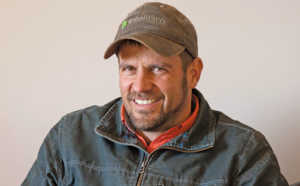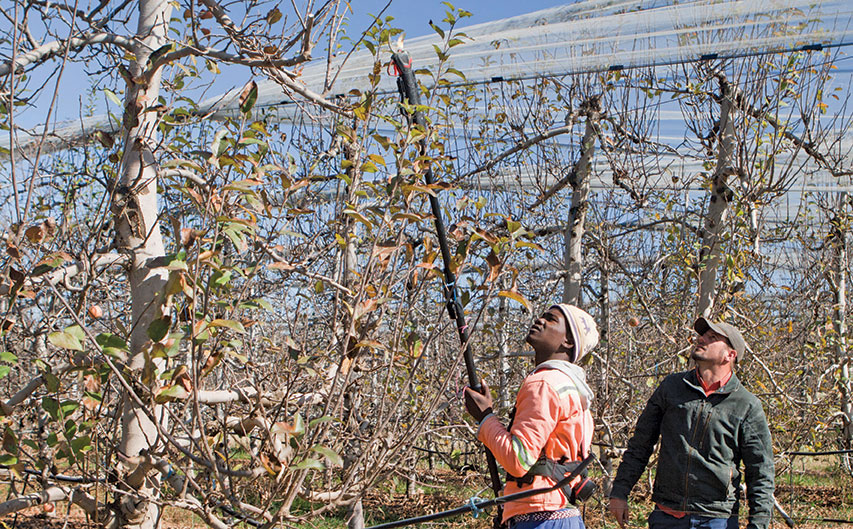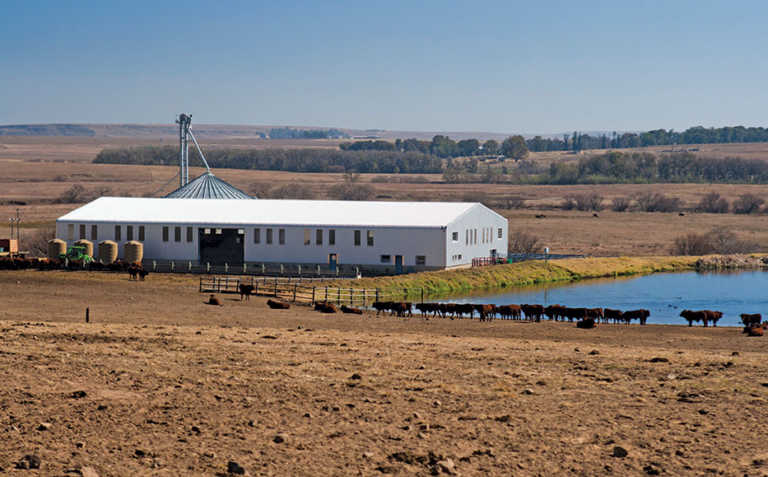Nelius Ferreira, 37, 2018 Free State Agriculture’s Young Farmer of the Year, says there are numerous elements that feed into the success of a family business.
But at Ferrero Bonsmaras the focus is undoubtedly on quality production.
Ferreira studied as an engineer before joining the farming operation in partnership with his father Kiewiet and brothers Theo and Johan.
The business, located on the farm Grootdraai near Harrismith in the eastern Free State, comprises six separate farm units and practises various types of cropping, as well as beef cattle production and apple farming.
The cropping component, managed by Ferreira’s father and brothers, remains the largest part of the business. It produces maize and potatoes, as well as sugar beans, soya beans and a small quantity of wheat.

The cattle component is his responsibility. It consists of the Ferrero Bonsmara stud, a large commercial operation, a feedlot, and a backgrounding system. He is also responsible for the family’s fruit farming interests, which comprise 32ha of apple orchards.
Cattle numbers vary according to grazing capacity, production phase and market conditions, but number several thousand at any given time. His feedlot has a standing capacity of 1 350 head of cattle, and there are plans to expand this. The stud herd numbers about 1 300 animals.
Ferreira adds value to his commercial stock by placing weaners in the feedlot and buying in feedlot or backgrounding stock at good prices. Feedlot animals are marketed to an abattoir. Commercial production and stud sales are also held on the farm.
Interwoven components
According to Ferreira, all aspects of the cattle operation are woven into the larger cropping business. For example, green feed is planted on potato lands after harvest to prevent wind erosion.
“It’s a bonus for the livestock component. There is an expense [planting cost], but then I do the calculation and see if I can make some added profit from the livestock off of the cover crops instead of just trying to protect the lands.”
READ Lucerne: A massive export market for ‘green gold’
The green feed or cover crops planted are prioritised to fit in with crop rotation.
Being part of a bigger business offers the advantage of having access to machinery for sowing grazing lands and baling harvest residue and hay.
The residue is absorbed into the livestock component and grains are used in the rations mixed on the farm. The cattle are also provided with Farmingbalanced commercial licks.
Grazing comprises a combination of natural sourveld grazing camps, and camps under Smuts finger or Eragrostis grasses.
The former can be grazed in summer or winter, while the Eragrostis is cut and baled.
Ferreira has scaled back on the Eragrostis area in recent years as he was producing too much for his needs, but he maintains an emergency feed bank. This has stood him in good stead in the recent dry years.
“I didn’t have to sell a single animal. In fact, I bought cattle in because I had that bank of surplus hay,” he says.
Attention to detail produces quality cattle
Ferreira, who recently retired as chairperson of the Free State Red Meat Producers’ Organisation, pays close attention to getting all basics of cattle production right.
These include maintaining biosecurity, selecting for performance and fertility, maintaining a strict vaccination programme, measuring through trials such as phase-D tests, ensuring fertility, and implementing traceability.
READ A more profitable way of running livestock
About 99% of the cattle in the commercial side of the business are Bonsmara, and 1% to 2% of the weaker cows are crossed with Charolais bulls. This is gradually being phased out, however. Ferreira says that while there is much to be said for hybrid vigour, it may put fertility at risk.
“The problem is the females, which we found were 20% to 30% less fertile on the same feed.”
He strives for good build that is still balanced by other traits.
“You can easily push build in a direction, saying this is the ideal shape, breadth, muscling and meat quantity, but that animal might not be fertile.”
He is a strong advocate for red cattle, which he says remain the “champions”; the cows calve easily and regularly every year and the resulting progeny are animals that grow rapidly to their optimal weight. This allows for expansion potential.
“How else are you going to grow [your business]? You need to get more calves on the ground,” he says.
He achieves a weaning percentage of about 90% throughout his herd.
Technology used precisely right
Ferreira stresses that while precision farming and technology are important, these tools need to be used properly and precisely to achieve their full potential.
There are several production herds on the farm and every animal is assigned a number. In addition, every stud animal has an electronic ear tag.
READ Drone technology maximises macadamia production
Ferreira uses best linear unbiased prediction (BLUP) values and genomics to evaluate and optimise performance. He also keeps computerised records.
“It’s about doing the right thing at the right time,” he says.
Nonetheless, he is forced to spend a large sum from time to time on unexpected interventions, such as preventing frost damage during flowering in his apple orchards.

For this, he contracts a helicopter with a pilot licensed for night-flying to break the inversion layer over his orchards. The helicopter’s rotor mixes the warm and cold air, limiting frost damage, a practice that was pioneered in Europe.
This might seem extreme, but the shade cloth over the trees protects only against hail, not frost, and untimely frost could wipe out a crop overnight.
“Compared with what I could lose, the cost is worth it,” he says.
Other innovations are simpler but equally important. They include using artificial insemination to add the genetics of a single bull to his herd.
For Ferreira, however, the key factor is achieving the desired results.
“It must work. It doesn’t make sense to talk about precision if you aren’t meeting with success.”
A bright future
He is optimistic about the future and says part of the reason he enjoys being a farmer is that he is working for his children and grandchildren. This includes building up his business and being involved in organised agriculture.
A passionate farmer, he says: “Farming is in my blood.” He realises, however, it is first and foremost a business that has to make a profit, and it cannot be pursued simply for the love of it. “It’s not just fun and games,” he says.
He adds that the South African agriculture sector needs dedicated farmers who have what it takes to compete in the global market.
He is upbeat about the future of the sector in South Africa, and has demonstrated this by investing in more land and planting new apple trees.
While he realises that he has no control over risks such as politics or the weather, he says he still arrives home to his wife Jomarli and his sons Cornel, 6, and Jean, 4, with a positive attitude towards his business, and he hopes this will inspire his sons to also farm one day.
“Everything we’re doing is for our children,” he says.



